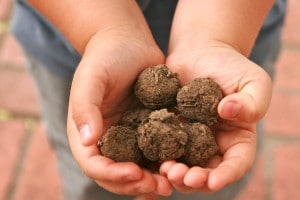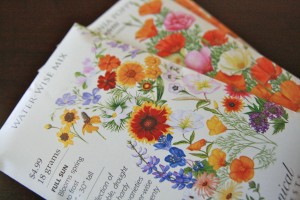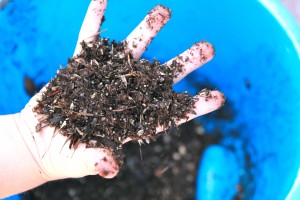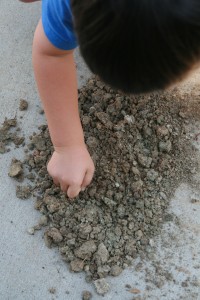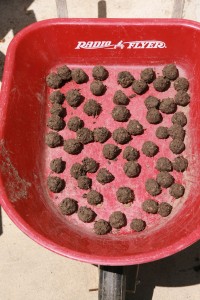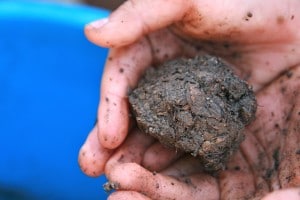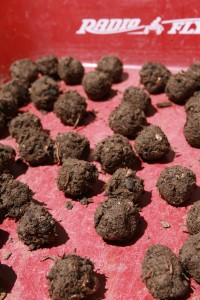Making Seed Balls for Earth Day
Contents
Looking for a fun and educational Earth Day activity? How about making some wildflower seed balls? This simple gardening project is sure to delight all ages, plus it’s a unique way to spread some green love over our beautiful planet.
I first discovered seed balls (also known as “seed bombs”) a couple of years ago at an Earth Day event in San Diego. They were these odd, truffle-sized pellets being sold out of what looked like a gumball machine. After my husband, son, and I got past our giggles and juvenile scat jokes, we learned something new that day: Seed balls are a quick and ingenious way of promoting plant life without having to do a ton of work.
Seed balls, then and now
Cultivation or reforestation via seed balls is not a new concept; I’ve read that some Native American tribes farmed this way. But the practice was reintroduced in the 1930s in Japan by natural farming pioneer, Masanobu Fukuoka, who used seed balls to grow grains in arid regions of his country. Fukuoka called this technique “do-nothing” farming because rigorous plowing of the soil was not necessary; all that was needed were the seed balls, some rain, and a little time.
Today, seed balls are used widely around the world to revive or cultivate vegetation in barren areas without having to till the land. And in big cities all around the U.S., seed balls have become tools of an environmental movement called “guerilla gardening,” in which eco-activists lob the balls onto unsightly and often trash-ridden abandoned lots in an effort to spruce up neglected neighborhoods, grow wholesome foods for the community, or both.
What are seed balls made of?
Seed balls consist of just four ingredients: seeds, compost, clay, and water. Everything is mixed together, molded into little spheres, and left to dry in the sun.
Be sure to use wildflowers that are native to your area. If you’re not sure, ask your local nursery.
How do seed balls work?
Once the balls are dry, they can be tossed onto practically any pile of dirt, where they will wait unmolested (the clay protects the seeds from being eaten by birds, rodents, and other animals) until they have absorbed enough rainwater to germinate. The compost provides all the nutrients the seeds need to grow.
How to make seed balls
In honor of Earth Day, you and your kids can create your own seed balls at home. All you need is some native wildflower seeds, compost, clay, and water―and the willingness to get a little really dirty!
Wildflower Seed Balls Recipe
(Yields about 40 to 50 jawbreaker-sized balls. Recipe courtesy of About.com.)
1 part native wildflower seeds (we used California poppies, Lupine, Compass, and a variety of water-wise wildflowers)
3 parts dry, organic compost
5 parts dry clay (I used native clay that hubby dug up for me, but lots of seed ball recipes suggest using powdered red pottery clay, available at fine art stores)
1 to 2 parts water
Large bucket to mix everything in
Large cookie sheet or tray for drying the seed balls (We used T’s wheelbarrow)
Now for the dirty work. (If picking mud out from under your fingernails is not your idea of fun, feel free to don a pair of rubber, latex, or nitrile gloves first.) Mix seeds and compost thoroughly by hand. Add in clay and mix again. Slowly add water and continue mixing by hand until well blended. You will know when you reach the right consistency when the mixture holds together in a ball without falling apart. Mold mixture into balls about the size of truffles (because it always comes back to food, doesn’t it?). Allow to dry on a flat surface in the sun for a minimum of one full day, or until they are completely dry. (Do not let balls sit moist for too long or they may begin to sprout!)
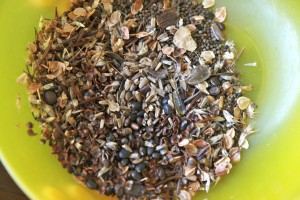
Eight seed packets yielded about half a cup of seeds in total.
Little hands delight in gardening because it is such a sensory experience.
T had a grand old time crushing up large chunks of gray native clay.
Your seed ball mixture is ready when once molded, it retains a ball shape without crumbling apart.
Camel droppings? Ew, no. Tiny parcels of potential life? Yes.
These seed balls are filled with everything needed to turn a barren lot into a lush and colorful garden again.
Once the balls are dry, you can package them up as unique and earth-conscious gifts, or embark on your first guerilla gardening expedition―just toss them onto a dirt pile, wait for some rain (or water it yourself), and then watch the fruits (or flowers) of your labor bloom.
It’s mid-spring, so we’re bound to have at least a few more rains left in the season. (April showers bring May flowers, right?) How about throwing a seed ball party? The more, the merrier! If you do, don’t forget to come back and let us know how it goes!
Happy Earth Day!

